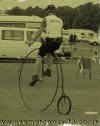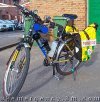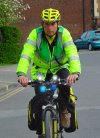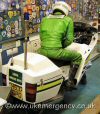Author: ukemergency
Paramedic Mark Inman is responding to a 999 call for…

Paramedic Mark Inman is responding to a 999 call for an ambulance. He knows all of the short cuts through the city of York to rapidly respond to calls.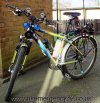
Mark has removed the panniers of medical equipment and entered the house of an 89 year old lady. She dialed 999 after damaging her hand by a fall when shopping. Mark arrived in three minutes after zipping through the traffic using his blue flashing lights and sirens.
An ambulance calmly arrives and the lady is prepared for transportation to hospital. Mark contacts the control room to let them know the details of the call before standing down.
This was the first bicycle to be featured on UKev…
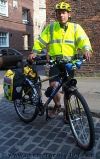
This was the first bicycle to be featured on UKev. On trial for 16 weeks in York’s city centre (during summer 2001, and then made permanent) is TENYAS’s (Tees, East and North Yorkshire Ambulance Service) paramedic life-cycle, fully equipped to cope with any emergency. The bike is quicker at getting through the tight, winding streets of York than a regular ambulance.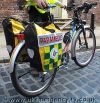
It is fitted out with white lights alongside blue flashing lights and a siren! The siren is similar to a car alarm, with the power provided by a large battery fitted where the water bottle would normally be. It also has a speedometer fitted.
There are two identical bikes, but only one paramedic to ride them. He responds to 2-3 calls per shift, travels about 30 miles per day, and is only used during daylight hours. Both bikes were donated by a private company. The panniers are heavily laden with equipment including an oxygen supply and a defibrillator. They lift off the bike to be carried to a casualty. The rider is equipped with a radio and a mobile telephone for communications. The real benefit of this system is that it is an inexpensive way of having an extra ‘ambulance’ on the road that can respond to emergencies.
RBH 540D This is a preserved Vauxhall Victor that was …
RBH 540D This is a preserved Vauxhall Victor that was originally purchased from Bridge Motors, Windsor, Berks and spent all of its working life with Slough Estates Ltd. on the Slough Trading Estate. It later moved to Northumberland County Council’s Ambulance Service. Notice the roof-top storage box and Winkworth warning bell on the front grille.
UOA 585 This green Austin Princess ambulance was…

UOA 585 This green Austin Princess ambulance was new in 1956. t was painted green to distinguish it from front line ambulances. It worked until 1979 as a factory ambulance for Hardy Spicer, Chester Road, Birmingham. It then passed through the hands of a number of preservationists who worked to restore it to its original condition. Notice the warning bell on the front bumper.
HUC 999W is a former London Ambulance Service…

HUC 999W is a former London Ambulance Service Control Unit from 1982. When this Ford based van left the front line ambulance fleet it was kept fully operational so it cold be used in the case of a major emergency.
The rear of the van has two telescoping communication aerials which would be raised once the control is established at an incident.
J529 OPM is a Renault Espace which was also…

J529 OPM is a Renault Espace which was also used by the LAS. The green and white chequers on the roof signify that this vehicle was used as a control unit.
The rear view of the Espace.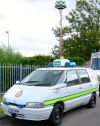
This view shows the roof mounted telescopic tower extended in order for the vehicle to be spotted at a major incident. Like the Ford above, it has been kept fully operational.
AEF 732C Moving even further back in time, this…

AEF 732C Moving even further back in time, this is a 1965 Commer ambulance maintained by Tees, East and North Yorkshire ambulance service. It has a top speed of 45 mph and throughout its life has only clocked up 8,000 miles.
Inside the back, showing the archaic equipment. This vehicle has been owned by the Civil Defence Corps, Hartlepool Ambulance Service and Cleveland Ambulance Service (all now defunct). The photos here shown it in 2005.
Road Accident
Road Accident (2007): Here we look at medics working alongside the other emergency services at a major road accident. This is an exercise that was carried out in Durham in May 2007. Casualties were provided by St. John Ambulance and local colleges and universities.
NK03 GWP is a North East Ambulance Service Ford Focus rapid response car. It has been abandoned by the roadside with its blue lights flashing as the crew has left to deal with multiple casualties.
NEAS incident support vehicles soon arrive, one towing a trailer. These secondary response vehicles carry large amounts of equipment, and in this instance their inflatable tent is required.
Quickly inflated, the tent is used as a triage shelter to assess casualties and prioritise them.
Due to the seriousness of the collision, one of the Great North Air Ambulances (G-HEMS) is called. Here it is landing with among the emergency vehicles and triage shelter.
Air ambulance doctors are shown here with Durham and Darlington Fire & Rescue extricating a driver impaled in the drivers seat of the van.
Careful coordination is needed to gently remove the windscreen and roof and then extricate the seriously injured casulaty.
HK08 ANX is a Renault Koleos horse ambulance. It…

HK08 ANX is a Renault Koleos horse ambulance. It is operated by Racehorse Ambulance Ltd. Notice how the blue light bar has been covered with a black cover for when the car is driven on the public roads. This is because an ambulance must be for the purpose of transporting sick or injured people.
The rear view of the silver Renault Koleos.
YE06 BYW This silver BMW X3 is a racehorse…

YE06 BYW This silver BMW X3 is a racehorse ambulance vehicle. It is fitted with a full blue light bar on the roof (covered in this photo) and dashboard-mounted repeaters. The car is has permanent 4-wheel drive and a powerful 3-litre engine. These features allows it to travel across rough ground easily as well as pull the heavy trailer.
The rear view of the car and trailer combination. The sponsor’s logo (BMW) can be seen on the trailer, as well as two additional blue flashing lights that are covered up.
M1 CVN This Citroen van is used as an emergency…

M1 CVN This Citroen van is used as an emergency veterinary ambulance in Merseyside. In the back is equipment that allows the treatment and transportation of animals that are in a critical condition. It has a double blue light on the roof and a repeater on the dashboard. These are used at events or when on emergency calls. When the vehicle is not on active emergency duty the lights are covered.
P831 NUK This is a Nissan Terrano II horse…

P831 NUK This is a Nissan Terrano II horse ambulance. It is four-wheel-drive and is equipped with a 2.7 litre turbo diesel engine with enough power and torque to smoothly pull a heavy trailer over grass.
The rear view of the same car. It is operated by Racecourse Ambulance Services Ltd.
The view of the Terrano and its similarly liveried trailer.
A three-legged mare gets out the back of the horse ambulance after a short journey from the racecourse to the stables.
A first for UK Emergency Vehicles, a quad bike…

A first for UK Emergency Vehicles, a quad bike. Clearly this vehicle is used as a rapid response horse ambulance. It is unclear whether the horse sits in front or behind the rider. Quad bikes are an unusual mode of transport for the emergency services, but there are ay least two examples of marked police quads in the UK.
Y36 TRP A Mercedes-Benz horse ambulance unit, on…

Y36 TRP A Mercedes-Benz horse ambulance unit, on duty at York racecourse (background). The Merc is fitted with blue lights and the trailer with two sets. The blue lights are used on the road, normally with a police escort, but covered up when not on active duty.
The rear view of the car and trailer. The quad bike (above) is transported in the trailer when moving between events.
Y915 TDH A Daihatsu 4×4 horse ambulance car…

Y915 TDH A Daihatsu 4×4 horse ambulance car.
Towed by the donated Daihatsu 4×4 is this horse ambulance trailer. Both car and trailer are fitted with blue lights and are used at equestrian events around the country. The trailer opens at both ends to allow the casualty to walk on and off easily. This is probably the only type of ambulance you won’t see at a hospital!
EU04 MAA is a Ford Galaxy from the first batch …

EU04 MAA is a Ford Galaxy from the first batch batch of marked cars used by VOSA. It has yellow and black battenburg side markings, yellow and orange chevrons at the rear and a roof bar with amber lights & variable matrix signing.
The front view, as you may see in your rear-view mirror when the inspectors wish to stop you. There are amber repeaters on the grille and a clear ‘VOSA’ sign on the high-visibility yellow bonnet. It has a white tax disc that grants the vehicle exemption from vehicle excise duty.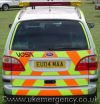
The rear and roof aspect. The long variable message matrix sign can be seen on the amber lightbar. Also the wording ‘enforcement control’ is written on the roof.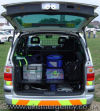
Inside the back of the Galaxy is a small amount of equipment, including temporary road and information signs. There is a very small rear-facing camera at the top left. An identical camera faces forwards on the dashboard. These cameras record whenever the vehicle is in use and have been used for prosecutions.

